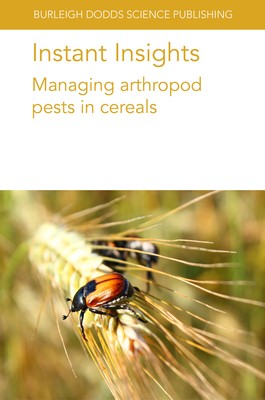
- We will send in 10–14 business days.
- Author: Marion O Harris
- Publisher: Burleigh Dodds Science Publishing Ltd
- ISBN-10: 1801466459
- ISBN-13: 9781801466455
- Format: 15.2 x 22.9 x 0.9 cm, minkšti viršeliai
- Language: English
- SAVE -10% with code: EXTRA
Instant Insights: Managing Arthropod Pests in Cereals (e-book) (used book) | bookbook.eu
Reviews
Description
This collection features three peer-reviewed reviews on managing arthropod pests in cereals.
The first chapter discusses key arthropod pests of cereals, including Hessian fly, orange wheat blossom midge, bird cherry oat aphid, greenbug, Russian wheat aphid, sunn pest, wheat stem sawfly and wheat curl mite. The chapter provides a detailed case study for each arthropod pest, exploring the pest's life cycle, its host plants and status as a wheat pest, best practices for managing populations, as well as our current understanding of plant susceptibility and plant resistance. The second chapter highlights the economic importance of corn/maize to the United States economy, citing that around 37.7 million hectares of land was used to grow the crop in 2021. As a result of its economic contribution, farmers are required to have an informed understanding of important pest species affecting the crop. The chapter considers recent advances in monitoring of native and invasive pests of corn and includes case studies on the European corn borer, corn earworm, western bean cutworm and corn rootworm to demonstrate the effective implementation of insect pest monitoring systems. The final chapter reviews the recent emergence of the Fescue aphid/grass aphid as an invasive pest of small grains outside of its native range of western Europe and the British Isles. The chapter considers the biology and management of the pest, its appearance and identification, its pest status and damage, as well as its potential for host plant resistance.EXTRA 10 % discount with code: EXTRA
The promotion ends in 23d.12:58:53
The discount code is valid when purchasing from 10 €. Discounts do not stack.
- Author: Marion O Harris
- Publisher: Burleigh Dodds Science Publishing Ltd
- ISBN-10: 1801466459
- ISBN-13: 9781801466455
- Format: 15.2 x 22.9 x 0.9 cm, minkšti viršeliai
- Language: English English
This collection features three peer-reviewed reviews on managing arthropod pests in cereals.
The first chapter discusses key arthropod pests of cereals, including Hessian fly, orange wheat blossom midge, bird cherry oat aphid, greenbug, Russian wheat aphid, sunn pest, wheat stem sawfly and wheat curl mite. The chapter provides a detailed case study for each arthropod pest, exploring the pest's life cycle, its host plants and status as a wheat pest, best practices for managing populations, as well as our current understanding of plant susceptibility and plant resistance. The second chapter highlights the economic importance of corn/maize to the United States economy, citing that around 37.7 million hectares of land was used to grow the crop in 2021. As a result of its economic contribution, farmers are required to have an informed understanding of important pest species affecting the crop. The chapter considers recent advances in monitoring of native and invasive pests of corn and includes case studies on the European corn borer, corn earworm, western bean cutworm and corn rootworm to demonstrate the effective implementation of insect pest monitoring systems. The final chapter reviews the recent emergence of the Fescue aphid/grass aphid as an invasive pest of small grains outside of its native range of western Europe and the British Isles. The chapter considers the biology and management of the pest, its appearance and identification, its pest status and damage, as well as its potential for host plant resistance.

Reviews